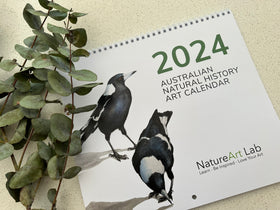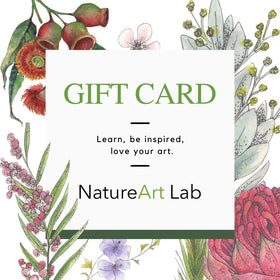
Montagu Island Nature Tour November 2020 - by Chris Davey
The visit to Montagu Island involved eighteen participants interested in art and the synthesis between art and the natural history of landscapes. The group departed late in the afternoon on Friday from Narooma jetty after a delay due to the swell at the Bar. The few hours spent at Narooma was not wasted with many taking a stroll along the boardwalk and Julia running the Introduction to Nature Journaling workshop. The delay allowed us to meet Anna Voytsekhovich, a professional scientist and scientific illustrator, botanical artist and wildlife illustrator who accompanied us on her first trip to the island. We also had the opportunity to meet Cameron, a second year apprentice chef who was to look after all our culinary needs. After an interesting exit from the harbour, we had an uneventful boat crossing with a choppy sea. Sea conditions led to very few birds seen with only the usual Silver Gull and Crested Tern reported.
The NPWS Ranger welcomed us to the island, after which we settled in to unpack before a walk down to the jetty to see the Little Penguins coming ashore. One of the volunteer tour guides on the island provided an informative introduction to the birds as we watched 35 penguins make their way up the shore to swap incubation duties or to feed their chick and change chick-minding duties.



After dinner Chris gave a PowerPoint presentation on the natural history of the island, covering geology, Aboriginal occupation, a brief history of the island since European times and an ecological overview of the vegetation. There are three species of shearwater, Little Penguins, Silver Gulls and Crested Terns, all busily breeding on the island. The island is also home to important south-eastern Australian colonies of Long-nosed and Australian Fur Seals.
On Saturday we started with a 6:00am early morning bird walk led by Chris, taking a slow amble along the 2.7 km of accessible mown paths covering the South Island. Alan also focused on some of the fascinating insect life on the island, providing participants with insights into resident species. After breakfast members of the group took a boat from the jetty to a near-by cove to snorkel with the seals. Although there was still a slight swell and the water not very clear we were able to appreciate the seals in their natural environment as they swam and played amongst us.
After morning tea an Introductory Drawing workshop run by Anna was held with a workshop on Basic Watercolour Techniques during the mid-afternoon.
A feature of this visit to the island was the perfect weather conditions and the Crested Terns breeding just off the front veranda of the living quarters. This allowed the various workshops to be held outdoors and virtually surrounded by the frenzied activities of breeding Crested Terns and Silver Gulls, both of which were busy incubating and raising chicks. Unfortunately, due to COVID-19 restrictions, we were not allowed up the lighthouse but Chris had received special permission to go up and take photos to help with an estimate of the number of Crested Terns at the various colonies.

After dinner Chris gave a second presentation on some of the research that had been done on the flora and fauna of the island. The presentation included the story of over 50 years of shearwater research, research on the Little Penguin, the revegetation program to control the invasive Kikuyu Grass and the eradication of the Goat, Rabbits and Mice from the Island.
On Sunday, after the early morning walk and breakfast, we were informed that the weather was about to change with a strong northerly likely to cause a swell that would prevent us leaving the island the next day. There was therefore a small window of opportunity to leave and half of the party, unable to take the risk of not departing the next day, departed by mid-morning.
Anna and Julia led watercolour workshops on painting Crested Gulls and Terns with artists sitting near the Crested Tern colony watching and sketching the adults, chicks and their eggs, all of which were easily visible close to the living quarters, see Photo 2. Chris provided insights into the bird behaviour, with Terns busily bringing in small fish for the chicks and defending their catch from the eager Silver Gulls.
We took a night walk to watch the Wedge-tailed and Short-tailed Shearwaters returning to the island to start egg-laying. Although we had observed both species feeding out to sea that afternoon very few came ashore and all we heard was the occasional moaning of the Wedge-tailed Shearwater in the distance. Again, Alan came to the fore with his expert knowledge of the insects on the island.
On the final day the weather had not turned out as forecast and so after the usual early morning nature walk, we packed up ready for departure with a final art class. The return crossing was on a lower swell than the trip out and accompanied by the usual Silver Gulls and Crested Terns with the occasional Short-tailed Shearwater and Australasian Gannet making an appearance.
Notes on the island’s fauna (South Island only).
Birds
- Stubble Quail- Not seen but one or two birds heard calling at the southern end of the island. To my knowledge not recorded previously.
- Brown Quail- Occasionally heard and once or twice seen on the mown paths.
- Little Penguin- 35 coming ashore at the jetty. Very few seen on paths at night
- Wedge-tailed Shearwater- Not assessed but seen feeding off-shore and very few coming in and calling at night.
- Short-tailed Shearwater - Not assessed. The occasional call only with egg-laying about to start.
- Australasian Gannet- One immature seen from the living quarters on Saturday 14 November.
- Great Cormorant- Seen each day .A maximum of 13 roosting on guano covered rocks on the western side
- Silver Gulls-.When considering the difference in distance surveyed in 2019 (650 m) and in 2020 (240 m) it appears that there were many more empty nests yet more 1 egg and 2 egg nests in 2020. This, and the observation that there were only one or two old nearly fledged chicks indicates that the start of 2020 season was not successful with few chicks surviving and the Silver Gulls had started to lay for a second time.
- Crested Tern- The Terns were nesting below the lighthouse and in front of the living quarters as three groups; a small group near the flag pole a second in front of the veranda and a third group further north. The lighthouse colony appeared to have started later with all birds incubating with many chicks at the other colonies. A count taken from the ground and from photographs taken from the lighthouse gave a total of 1911 incubating adults and birds with nearby chicks, slightly down from the previous two years.
- Sooty Oystercatcher - Minimum eleven birds.
- Buff-banded Rail – None seen but a minimum of five calling on any one walk.
- White-bellied Sea-Eagle - 1 adult and 1 immature seen most days.
- Swamp Harrier- 1 adult recorded each day.
- Black-shouldered Kite- A single bird seen on Saturday and Sunday.
- Peregrine Falcon- 2 adult.
- Crimson Rosella- The same three birds seen during the Saturday and Sunday morning bird walks.
- Dollarbird- Possibly the first record for the island seen on Sunday perched in tree canopy on the western side of the island.
- Yellow-faced Honeyeater- Many throughout the more wooded western shore.
- Golden-headed Cisticola – A minimum of nine heard on each morning walk.
- Little Grassbird- Minimum of 5 heard on morning walks.
- Welcome Swallow- A minimum of 18 with no record of breeding.
Chris Davey and Julia Landford



Comments
Leave a comment